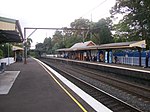Berowra Valley National Park
2012 establishments in AustraliaHornsby ShireIUCN Category IINational parks of New South WalesParks in Sydney ... and 4 more
Protected areas established in 2012Urban forestsUse Australian English from October 2014Valleys of Australia

The Berowra Valley National Park is a protected national park that is located in northern Sydney, New South Wales, Australia. The 3,884-hectare (9,600-acre) national park is situated approximately 20 kilometres (12 mi) north-west of the Sydney central business district. Located within the Sydney Basin, the park is part of the dissected Hornsby Plateau which is dominated by Hawkesbury Sandstone and predominantly covers the catchment area of Berowra Creek.
Excerpt from the Wikipedia article Berowra Valley National Park (License: CC BY-SA 3.0, Authors, Images).Berowra Valley National Park
Tarro Close, Sydney
Geographical coordinates (GPS) Address Nearby Places Show on map
Geographical coordinates (GPS)
| Latitude | Longitude |
|---|---|
| N -33.681666666667 ° | E 151.10111111111 ° |
Address
Tarro Close 8
2077 Sydney
New South Wales, Australia
Open on Google Maps








